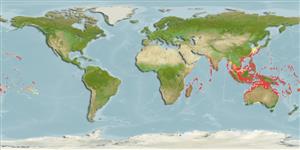Common names from other countries
>
Eupercaria/misc (Various families in series Eupercaria) >
Lutjanidae (Snappers) > Lutjaninae
Etymology: Lutjanus: Malay, ikan lutjan, name of a fish.
More on author: Forster.
Environment: milieu / climate zone / depth range / distribution range
Ecología
marino; agua dulce; salobre asociado a arrecife; rango de profundidad 1 - 80 m (Ref. 9710). Tropical; 20°C - 28°C; 34°N - 34°S, 28°E - 134°W (Ref. 55)
Indo-Pacific: East Africa to the Marquesas and Line islands, north to southern Japan, south to Australia (Ref. 9821). Records from the Red Sea and Persian Gulf are outside distributional range (Ref. 114545).
Length at first maturity / Tamaño / Peso / Age
Maturity: Lm 20.6 range ? - ? cm
Max length : 40.0 cm TL macho / no sexado; (Ref. 55); common length : 25.0 cm TL macho / no sexado; (Ref. 30573); edad máxima reportada: 34 años (Ref. 107771)
Espinas dorsales (total) : 10; Radios blandos dorsales (total) : 14; Espinas anales: 3; Radios blandos anales: 8. This species is distinguished by the following characters: body with greatest depth 2.3-2.8 in SL; preopercular notch and knob well developed; vomerine tooth patch crescentic, without a medial posterior extension; tongue smooth, without teeth; gill rakers of first gill arch 6-7 + 10-14 = 16-20 (including rudiments); caudal fin slightly emarginate; scale rows on back rising obliquely above lateral line. Colour of back and sides tan, grey to brownish, sides usually with a series of narrow yellow of golden-brown stripes, 1 per scale rows, caudal fin blackish, dorsal and caudal fins with a narrow white border; pectoral, pelvic and anal fins yellowish, and a broad yellow rim around posterior eye (Ref. 9821, 90102).
Adults inhabit lagoon and semi-protected seaward reefs (Ref. 9710). They prefer sheltered areas with deep holes or large boulders (Ref. 37816). Benthopelagic (Ref. 58302). Solitary or in loose aggregations (Ref. 90102). Juveniles sometimes found in shallow mangrove swamps and the lower parts of freshwater streams. Adults feed at night on fishes, shrimps, crabs, holothurians and cephalopods (Ref. 30573). Commonly seen in markets, usually fresh. Caught with handlines, traps, and gill nets. This fish sometimes causes ciguatera poisoning, particularly in the Pacific portion of its range (Ref. 9821). Maximum depth reported taken from Ref. 9773.
Allen, G.R., 1985. FAO Species Catalogue. Vol. 6. Snappers of the world. An annotated and illustrated catalogue of lutjanid species known to date. FAO Fish. Synop. 125(6):208 p. Rome: FAO. (Ref. 55)
IUCN Red List Status (Ref. 130435)
CITES (Ref. 128078)
Not Evaluated
Threat to humans
Reports of ciguatera poisoning (Ref. 4690)
Human uses
Pesquerías: comercial; pesca deportiva: si; Acuario: Comercial
Herramientas
Special reports
Download XML
Fuentes de Internet
Estimates based on models
Preferred temperature (Ref.
115969): 24.6 - 29, mean 28 (based on 1452 cells).
Phylogenetic diversity index (Ref.
82804): PD
50 = 0.5000 [Uniqueness, from 0.5 = low to 2.0 = high].
Bayesian length-weight: a=0.01514 (0.01319 - 0.01737), b=2.97 (2.94 - 3.00), in cm Total Length, based on LWR estimates for this species (Ref.
93245).
Nivel trófico (Ref.
69278): 3.6 ±0.5 se; based on diet studies.
Resiliencia (Ref.
120179): Medio, población duplicada en un tiempo mínimo de 1.4-4.4 años (tmax=4).
Fishing Vulnerability (Ref.
59153): Low to moderate vulnerability (29 of 100).
